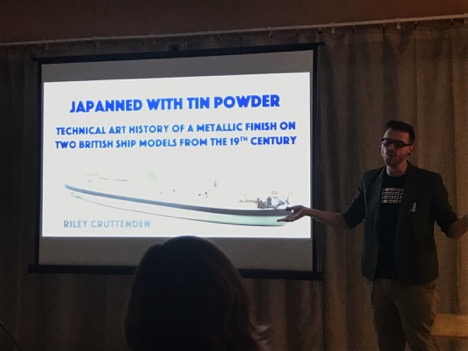Talk Title: “Japanned with Tin Powder: Technical Art History of a Metallic Finish on Two British Ship Models from the 19th Century”
Speaker: Riley Cruttenden, Conservation Technician at the United States Holocaust Memorial Museum and Communication Co-Officer on AIC’s Emerging Conservation Professionals Network. He is a graduate of University of Glasgow’s master’s program in Technical Art History and recipient of a 2016-17 US-UK Fulbright Study Award.

Riley Cruttenden presented on his technical investigation of the tin japanned finish on two ship models at the Rijksmuseum and his reconstructions of the technique. The two ornamental ship models “De Tijger” and “De Buffel” studied were presentation models created as a gift for the Dutch Navy after they commissioned ships. Both ship models have a silver finish on the bottom. They have slightly different appearances; both have their original tin Japanned finish, but one has been overpainted with aluminum. Japanning is the imitation of Asian lacquer by people in the West. It often involves the application of metal leaf, metal flake, and/or metal powder onto Japan size, which is a type of mordant or glue.
Cruttenden explained Technical Art History as the intersection of researching art technological resources (literature and other evidence of art-making processes from the past), a technical investigation of the object/technique, and a technical reconstruction. He applied a variety of analytical techniques for analysis of the tin japanned finish during his technical investigation. Imaging of cross sections revealed three ground layers, a layer of Japan size, powdered tin, varnish, and finally the aluminum restoration paint.
Cruttenden researched what instructions would have been available for tin Japanning at the time the ship models were made. He found that the substrate used was often wood, though paper and other materials were also Japanned. Often, there was a size/animal glue layer applied to the substrate. Some literature descriptions/instructions include application of a lead white or calcium carbonate layer, specifically for silver imitation finishes (this would not have been used on black furniture, for example). The next layer described was the Japan size, followed by the tin powder, and finally the varnish. For his technical reconstruction, Cruttenden applied a layer of animal glue size to prepared wood panels. He found prepared tin powder with the same particle size as that on the ships (measured during SEM imaging). He wanted to make the Japan size himself, and he found three 19th-century recipes that would have been available at the time the ships were made. An 1803 text described an oil-resin varnish (mostly oil), an 1837 text described spirit varnish in turpentine, and an 1863 text described an oil-resin varnish (mostly resin). Using copal resin, linseed oil, and turpentine, he followed the instructions, which included boiling turpentine and linseed oil, to make the three versions of Japan size. The three sizes varied in color and viscosity. He applied them to his test panels, and then applied the tin at the appropriate dryness. The tin powder was applied at the point of dryness when the size could be touched, leaving behind a fingerprint, without any of it coming away on the finger. Since only a small area could be finished with size and tin at a time, Cruttenden experimented with how to overlap working areas, creating seams. SEM imaging of one of the cross sections from the ship models revealed a double layer of tin and size, likely indicating a seam. Finally, Cruttenden compared burnishing the tin with a cloth versus burnishing with agate; the two methods provided different finishes. His research has greatly improved the understanding of the technique applied on the Rijksmuseum model ships and tin Japanning in general, as well as contributed to the overall body of conservation knowledge on model ships.
Summarized by Haddon Dine, Graduate Intern at The Walters Art Museum, Third-year Graduate Fellow in the Winterthur/University of Delaware Program in Art Conservation